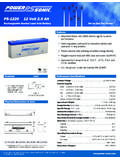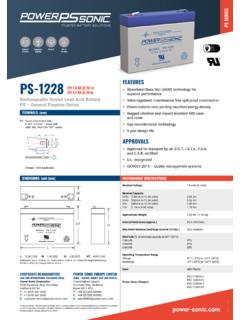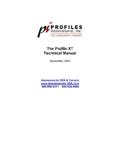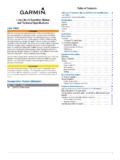Transcription of Features of Power-Sonic Sealed Lead Acid Batteries
1 Features of Power-Sonic Sealed Lead acid Batteries ..1 Battery Construction ..2 Theory of Operation ..3 & 4 Battery Capacity ..5 & 6 Battery Capacity Selector ..7 Performance Data ..8 Discharge ..8 Open Circuit Voltage ..8 Temperature ..9 Shelf Life and Storage ..10 Battery Life ..10-11 Over Discharge ..12 Charging ..12 Charging Techniques Summary ..13 Charging Charging Methods ..13 Constant Voltage Charging ..14 Constant Current Charging ..15 Taper-Current Charging ..15 Overcharging ..16 Undercharging ..16 Charging for Cycle Operation ..16 Charging for Standby Operation ..16 Two-Step Constant Voltage Charging ..17 Charging in Series ..17 Charging in Parallel.
2 18 Temperature Compensation ..18 Top Charging ..18 Charging Efficiency ..19 Important Do s and Don ts ..20 Handling ..20 Installation ..20 Charging ..21 Notes ..22 Glossary ..24 Table of ContentsSealed/Maintenance FreeThe valve regulated spill proof construction allows trouble-free safe operation in any position. There is no need to add electrolyte, as gases generated during the charge phase are recombined in a unique oxygen cycle . Power-Sonic Sealed lead acid Batteries can be operated in virtually any orientation without the loss of capacity or electrolyte leakage. However, upside down operation is not Shelf LifeA low self-discharge rate, up to approximately 3% per month, may allow storage of fully charged Batteries for up to a year, depending on storage temperatures, before charging becomes critical.
3 However, we strongly recommend that all Batteries should be recharged within six months of receipt as it will enhance their long term life. Please refer to this Technical Manual and individual battery specification sheets for more details. Design FlexibilitySame model Batteries may be used in series and/or parallel to obtain choice of voltage and capacity. The same battery may be used in either cyclic or standby applications. Over 80 models available to choose from. Deep Discharge RecoverySpecial separators, advanced plate composition and a carefully balanced electrolyte system ensure that the battery has the ability to recover from excessively deep high watt-hour per dollar value is made possible by the materials used in a Sealed lead- acid battery; they are readily available and low in HandlingNo special handling precautions or shipping containers, surface or air, are required due to the leak-proof construction.
4 Please refer to the declaration of non restricted status for and as listed in the Literature section of our website: Batteries utilize state of the art design, high grade materials, and a carefully controlled plate-making process to provide excellent output per cell. The high energy density results in superior power /volume and power /weight Pressure Valve RegulatorsAll Batteries feature a series of low pressure one-way relief valves. These valves safely release any excessive accumulation of gas inside the battery and then Discharge RateLow internal resistance allows discharge currents of up to ten times the rated capacity of the battery. Relatively small Batteries may thus be specified in applications requiring high peak Operating Temperature RangePower- sonic Batteries may be discharged over a temperature range of -40 C to +60 C (-40 F to + 140 F) and charged at temperatures ranging from -20 C to +50 C (-4 F to +122 F).
5 Rugged ConstructionThe high impact resistant battery case is made of non-conductive ABS plastic. The case materials impart great resistance to shock, vibration, chemicals and heat. Flame Retardant (FR) battery cases and lids are available where the end application dictates. Long Service LifePS/PSH and PSG Series: Have a design life of up to five years in standby applications. In cyclical applications up to 1,000 charge/discharge cycles can be expected depending on average depth of discharge. PG Series: Have a design life of up to 10 years in float consult this Technical Manual and product specifications to become aware of the many factors that effect product information contained within is provided as a service to our customers and is for their information only.
6 The information and recommendations set forth herein are made in good faith and are believed to be accurate at the date compiled. Power-Sonic Corporation makes no warranty expressed or of Power-Sonic Sealed Lead acid Batteries Power-Sonic Rechargeable Batteries Battery ConstructionRelief valveIn case of excessive gas pressure build-up inside the battery, the relief valve will open and relieve the pressure. The one-way valve not only ensures that no air gets into the battery where the oxygen would react with the plates causing internal discharge, but also represents an important safety device in the event of excessive overcharge. Vent release pressure is between 2-6 psi; the seal ring material is neoprene on the model, Batteries come either with AMP Faston type terminals made of tin plated brass, post type terminals of the same composition with threaded nut and bolt hardware, or heavy duty flag terminals made of lead alloy.
7 A special epoxy is used as sealing material surrounding the dilute sulfuric acid : separators are made of non-woven glass fiber cloth with high heat and oxidation resistance. The material further offers superior electrolyte absorption and retaining ability, as well as excellent ion (electrodes) Power-Sonic utilizes the latest technology and equipment to cast grids from a lead-calcium alloy free of antimony. The small amount of calcium and tin in the grid alloy imparts strength to the plate and guarantees durability even in extensive cycle service. Lead dioxide paste is added to the grid to form the electrically active material. In the charged state, the negative plate paste is pure lead and that of the positive lead dioxide.
8 Both of these are in a porous or spongy form to optimize surface area and thereby maximize capacity. The heavy duty lead calcium alloy grids provide an extra margin of performance and life in both cyclic and float applications and give unparalleled recovery from deep Design & Operational SafetyThe leak proof construction of Power-Sonic Batteries has ensured that our Batteries have been approved for shipment by air, both by and Copies of these approvals are available on our website: s component recognition program for emergency lighting and power Batteries lists Power-Sonic under file number MH20845 Case SealingDepending on the model the case sealing is ultrasonic, epoxy or heat and lid material is ABS, high impact, resin with high resistance to chemicals and flammability.
9 Case and cover are made of non-conductive ABS plastic to UL94-HB or UL94 V-O. This case has molded-in dividers for each 2 volt Rechargeable Batteries DischargeDuring the discharge portion of the reaction, lead dioxide (PbO2) is converted into lead sulfate (PbSO4) at the positive plate. At the negative plate sponge lead (Pb) is converted to lead sulfate (PbSO4). This causes the sulfuric acid (2H2SO4) in the electrolyte to be consumed. Figure : Chemical reaction when a battery is being dischargedChargeDuring the recharge phase of the reaction, the cycle is reversed. The lead sulfate (PbSO4) and water are electrochemically converted to lead (Pb), lead dioxide (PbO4) and sulfuric acid (2H2SO4) by an external electrical charging source.
10 Figure : Chemical reaction when a battery is being chargedTheory of OperationThe basic electrochemical reaction equation in a lead acid battery can be written as: Oxygen Recombination To produce a truly maintenance-free battery, it is necessary that gases generated during overcharge are recombined in a so-called oxygen cycle . Should oxygen and hydrogen escape, a gradual drying out would occur, eventually affecting capacity and battery life. During charge, oxygen is generated at the positive and reacts with and partially discharges the sponge lead of the negative. As charging continues the oxygen recombines with the hydrogen being generated by the negative, forming water.















